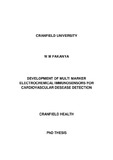JavaScript is disabled for your browser. Some features of this site may not work without it.
| dc.contributor.advisor | Tothill, Ibtisam E. | |
| dc.contributor.author | Fakanya, Wellington | |
| dc.date.accessioned | 2014-03-26T09:25:09Z | |
| dc.date.available | 2014-03-26T09:25:09Z | |
| dc.date.issued | 2012-08 | |
| dc.identifier.uri | http://dspace.lib.cranfield.ac.uk/handle/1826/8361 | |
| dc.description.abstract | Cardiovascular disease (CVD) is the world’s biggest killer, globally accounting for over 17,5 million deaths annually. Almost half of these deaths are caused by acute myocardial infarction. It is an umbrella term that encompasses several medical conditions associated with the heart and the circulatory system. It is important to detect patients with high risk of acute myocardial infarction quickly. This can help in cutting costs by screening the hospital admissions process and focusing resources to those that are specifically at risk. Biomarkers and biosensors are playing a crucial role in the diagnostic revolution of cardiovascular disease. Although significant studies have been done on electrochemically transduced biosensors for detecting CVDs, of late they have had limited commercial success. However, advances in interrelated research areas have made it possible for faster, accurate, portable and environmentally friendly electrochemical diagnostic devices to be made. This project aims to: • Develop Immunoassays for two cardiac biomarkers which are CRP and cardiac troponin T • Integrate the immunoassays on to screen-printed gold electrodes (SPGE) to make electrochemical immunosensors. • Optimise the immunosensors to produce rapid, sensitive and specific devices • Evaluate the performance of the optimised immunosensors compared to other alternative detection devices. Some aspects of the fabrication process of screen-printed gold electrodes were investigated particularly ink compositions and curing techniques. It was found that the quality of the carbon ink affects the performance of the electrodes and that curing electrodes with conventional oven drying gave better performance to high throughput infra-red drying. Initially a plate based ELISA assay for CRP was developed before the assay was transferred onto screen-printed gold electrodes. Antibodies were immobilised using passive adsorption and after optimisation of the screen-printed immunosensor, it managed to detect CRP with a limit of detection of 0.52 µg mL-1 with a linear range up to 20 µg mL-1 in spiked serum. This was within diagnostically relevant range. Comparison of the assay with a commercial alternative gave good correlation (R2 value of 0.99). A second immunosensor was developed for cardiac Troponin T (cTnT) using similar screen-printed gold electrodes. In this immunosensor, the use of self-assembled monolayers (SAMs) was employed to assist in covalent immobilisation, orientation and preservation of the capture antibody. A method for depositing the 11-mercaptoundecanoic acid (11-MUA) SAMs on the gold working electrode without compromising functionality of the other electrodes was developed. It was found that the use of self-assembled monolayers increased the sensitivity of the assay enabling it to decrease the limit of detection on the immunosensor from 2.12 ng mL-1 (passive adsorption) to 1.14 ng mL-1 (SAM assisted covalent immobilisation). It was also found that the use of SAMs enhanced the shelf life of the immobilised antibody compared to those passively adsorbed. The use of gold nanoparticles to amplify the immunosensor signal was explored .This further improved the sensitivity of the cTnT assay. The final immunosensor setup comprising the use of 11-MUA self-assembled monolayers and 60 nm conjugated gold nanoparticles enabled the detection of cTnT with a limit of detection of 0.51ng mL-1 in buffer and 0.58 ng mL-1 in 75% serum samples. This assay was benchmarked against a hospital analyser and a quartz crystal microbalance biosensor (QCM-1). It gave comparable results with correlation values of 0.99 and 0.95. The two developed immunosensors for CRP and cTnT can easily be integrated onto an electrochemical analyser to make a multi-marker electrochemical immunosensor for detecting cardiovascular diseases. | en_UK |
| dc.language.iso | en | en_UK |
| dc.publisher | Cranfield University | en_UK |
| dc.rights | © Cranfield University 2012. All rights reserved. No part of this publication may be reproduced without the written permission of the copyright owner | en_UK |
| dc.title | Development of multi marker electrochemical immunosensors for cardiovascular desease detection | en_UK |
| dc.type | Thesis or dissertation | en_UK |
| dc.type.qualificationlevel | Doctoral | en_UK |
| dc.type.qualificationname | PhD | en_UK |
